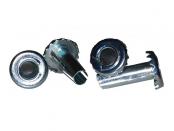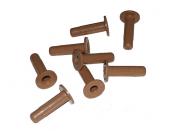Click Here: How to remove a Castor from a chair base
Removal of style #5205 steel castor socket
This is best done with a screw driver by prying the metal teeth up off the wood and then prying out from the leg.
Often, the teeth portion comes loose or has been previously broken off leaving metal inside the leg hole. The metal must be removed and is done with only a 11/32" drill bit. When drilling down about 3/4", the slow turning drill bit will "catch" the metal and cause it to spin around. Then, while it is slowly spinning...withdraw the drill and drill bit along with the broken metal piece. The broken piece can be removed from the drill bit with a pliers in a twisting motion. High drill speeds must be avoided. ANY drilling deviation from 90° will cause caster tracking problems.
Removal of #5208 Tan plastic Socket
Similar to above #5205 removal, but use 3/8" drill bit size instead. Some original installations included 2 small nails which must be removed first.
Notes:
Do not use a drill bit the size of the outside diameter (7/16") of the #5208 socket being removed. Doing so may slightly enlarge the hole to where the socket will not fit properly. Removal by drilling using the proper drill bit is best and insures that the hole has not been enlarged.
If switching from the #5205 metal socket to the Tan Plastic socket, the hole size after removal must be increased to 7/16". The original smaller hole will guide the drilling of the 7/16" bit accurately if you don't drill the depth too quickly. Start slowly! When drilling, it is absolutely essential that the hole being bored is at 90 degrees. Any deviation will cause that castor to not "track" properly, causing much annoyance.
An advantage of switching to the Tan Plastic socket style #5208 is that a loose wallowed out hole caused by a #5205 metal socket will often be corrected...within limitations of course.